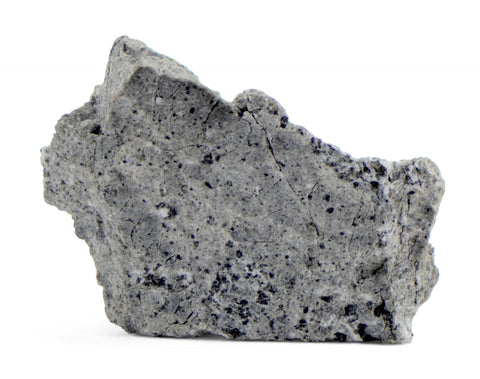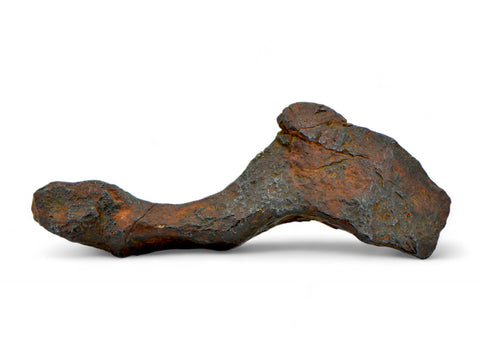48.11g CANYON DIABLO Graphite Nodule
On Offer: A 1.5 inch by 1.2 inch 48.11 gram complete graphite nodule from the Canyon Diablo meteorite.
These nodules are not very common. Whole Canyon Diablo graphite nodules are rather rare, as they tend to cut to reveal the metal veins that are often found transecting the interior of the graphite. In addition to the metal veins, many of these nodules also contain micro diamonds (and less frequently mm to cm sized diamond inclusions). These diamond inclusions were likely created by the high temperatures and pressures created either during the impact event on Earth or during asteroidal collisions in space prior to hitting the Earth. These graphite nodules represent a unique part of the story of this world-renowned hypervelocity meteorite impact event and the massive crater it created when it hit the Earth. On an interesting side not, because they are made mostly of carbon in the form of graphite, they can be used to draw just like a pencil!
First Found: *1891
*Hopi and Navajo peoples of northern Arizona have oral traditions that incorporate the Meteor Crater, indicating that local indigenous peoples were aware of both the crater and the metal meteorite associated with it. There is also some evidence that metal from the meteorite was used by these indigenous peoples for various functional and decorative purposes.
*It is very likely local indigenous peoples witnessed this event and oral tradition from the Hopi and Navajo supports this hypothesis. However, in the strictest sense of this term it is not considered a witnessed fall.
Formation: "Formation of the large graphite nodules is contentious. One interpretation is that the metal veins within the nodules are the product of shock melting of the host meteorite with metal bing injected at high T into the graphite, which subsequently cooled quickly. However, suggests that the nodules formed at relatively low T as the veins show areas rich in refractory PGEs that coexist with those depleted in these elements at the sub-mm scale. They suggest the recrystallized texture of the metal is indicative of a “brief and moderate thermal event” and that the iron did not form from a metal melt. As such, proposed the formation of CD via a chemical vapor deposition mechanism. Similarly, measured primordial noble gases within a graphite nodule and deduced from the HL/Q ratio that the graphite-metal inclusion was heated to 600° C at most. However, iron formation at low T is inconsistent with the more commonly held view of their crystallization from a high T melt that cooled through the austenite region of the Fe-Ni phase diagram. Currently, the relationship between the carbon and its characteristics in the large nodules (containing polycrystalline kamacite and cliftonite) and the more common cm-sized nodules of carbon±troilite and mantled by schreibersite±cohenite is unknown. It is possible that the graphite in the larger nodules represent “fossil” carbon accumulations, and as such has the potential to give insights into previous stages of their formation history." Excerpt from: OBSERVATIONS ON A 10-KG GRAPHITE NODULE FROM THE CANYON DIABLO (IAB-MG) IRON METEORITE. Laurence A. J Garvie, Center for Meteorite Studies, Arizona State University. Citations were removed for brevity, please see original paper for full text and citations.
What you get: 48.11 gram Canyon Diablo graphite nodule as shown, & signed Certificate of Authenticity.
We offer a 100% no questions asked 30 day return policy.
SEE OFFICIAL METEORITICAL SOCIETY ENTRY BELOW
| Canyon Diablo | |||||||||||||||||
|---|---|---|---|---|---|---|---|---|---|---|---|---|---|---|---|---|---|
| Basic information |
Name: Canyon Diablo This is an OFFICIAL meteorite name. Abbreviation: There is no official abbreviation for this meteorite. Observed fall: No Year found: 1891 Country: United States Mass: 30 t |
||||||||||||||||
| Classification history: |
This is 1 of 120 approved meteorites classified as Iron, IAB-MG. |
||||||||||||||||
From Wikipedia:
"The Canyon Diablo meteorites include the many fragments of the asteroid that created Barringer Crater (Meteor Crater), Arizona, United States. Meteorites have been found around the crater rim, and are named for nearby Canyon Diablo, which lies about three to four miles west of the crater."
The Canyon Diablo meteorites include the many fragments of the asteroid that created Barringer Crater (Meteor Crater), Arizona, United States. Meteorites have been found around the crater rim, and are named for nearby Canyon Diablo which lies about three to four miles west of the crater.
History
The asteroid fell about 50,000 years ago. The meteorites have been known and collected since the mid-19th century and were known and used by pre-historic Native Americans. The Barringer Crater, from the late 19th to the mid-20th century, was the center of a long dispute over the origin of craters that showed little evidence of volcanism. That debate was settled in the 1950s thanks to Eugene Shoemakers' study of the crater.
In 1953, Clair Cammeron Patterson measured ratios of the lead isotopes in samples of the meteorite. The result permitted a refinement of the estimate of the age of the Earth to 4.550 billion years (± 70 million years).
Composition and classification
This meteorite is an iron octahadrite. Minerals reported from the meteorite include:
- Cohenite - iron carbide
- Chromite - iron magnesium chromium oxide
- Daubréelite - iron(II) chromium sulfide
- Diamond andIonsdaleite - carbon
- Graphite- carbon
- Haxonite - iron nickel carbide
- Kamacite iron nickel alloy - the most common component.
- Base Metal Sulfides
- Scheidbesite - iron nickel phosphide
- Taenite - iron nickel alloy
- Trolite - a variety of the iron sulfide mineral pyrrhotite. The troilite in this sample is used as the standard reference for sulfur isotope ratios.
- Moissanite - a variety of silicon carbide, the second hardest natural mineral.
Samples may contain troilite-graphite nodules with metal veins and small diamonds.
We Also Recommend


















